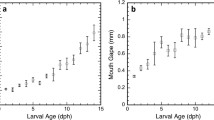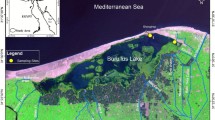Abstract
Rates of predation by the invertebrates Aurelia aurita, Thysanoessa raschi and Euchaeta norvegica on larval stages of cod (Gadus morhua L.), flunder (Platichthys flesus L.), plaice (Pleuronectes platessa L.), herring (Clupea harengus L.), and turbot (Scophthalmus maximus L.) were determined. Experiments were conducted in late winter and early spring 1982 with predators collected in Loch Etive, Scotland and prey obtained from several locations in Great Britain. Early stages of the smallest species, cod, flounder and turbot, tended to be most vulnerable to all three predators, while the early stages of the larger species, plaice and herring, and older stages of all species, were less vulnerable. For all stages and species of larvae, predation rates by the three predators were most closely related to larval length and escape swimming speed. Larval length itself was closely correlated to indices of larval escape ability. Low predation rates on large larvae by E. norvegica could be due to handling difficulties, whereas for A. aurita and T. raschi these low rates were due to escape abilities of the larger larvae. Prey movement is an important stimulus eliciting predation in E. norvegica but not in A. aurita or T. raschi.
Similar content being viewed by others
Literature cited
Bailey, K. M. and R. S. Batty: A laboratory study of predation by Aurelia aurita on larval herring (Clupea harengus): experimental obervations compared with model predictions. Mar. Biol. 72, 295–301 (1983)
Bailey, K. M. and J. Yen: Predation by a carnivorous marine copepod, Euchaeta elongata Esterly, on eggs and larvae of the Pacific hake, Merluccius productus. J. Plankton Res. 5, 71–82 (1983)
Batty, R. S.: Observations of fish larvae in the dark with television and infra-red illumination. Mar. Biol. 76, 105–107 (1983)
Blaxter, J. H. S., J. A. B. Gray and A. C. G. Best: Structure and development of the free neuromast and lateral line system of the herring. J. mar. biol. Ass. U.K. 63, 247–260 (1983)
Dixon, W. and F. Massey: Introduction to statistical analysis, 638 pp. New York: McGraw-Hill, Inc. 1969
Draper, N. and H. Smith: Applied regression analysis, 407 pp. New York: John Wiley & Sons 1966
Gerritsen, J.: Adaptive responses to encounter problems. In: Evolution and ecology of zooplankton communities. pp 52–62. Ed. by W. C. Kerfoot. Hanover, New Hampshire: University. Press 1980
Hamner, P. and N. Hamner: Chemosensory tracking of scent trails by the planktonic shrimp Acetes sibogae australis. Science, N.Y. 195, 886–888 (1977)
Kuhlmann, D.: Laboratory studies of the feeding behaviour of the chaetognaths, Sagitta setosa J. Müller and S. elegans Verril with special reference to fish eggs and larvae as food organisms. Meeresforsch. Rep. mar. Res. 25 (Sdbd), 163–171 (1977). (Ber. dt. wiss. Kommn Meeresforsch.)
Lillelund, K. and R. Lasker: Laboratory studies of predation by marine copepods on fish larvae. Fish. Bull. U.S. 69, 655–667 (1971)
Mauchline, J.: The biology of euphausiids. Adv. mar. Biol. 18, 373–595 (1980)
Möller, H.: Scyphomedusae as predators and food competiors of larval fish. Meeresforsch. Rep. mar. Res. 28, 90–100 (1980). (Ber. dt. wiss. Kommn Meeresforsch.)
Purcell, J. E.: Feeding ecology of Rhizophysa eysenhardti, a siphonophore predator of fish larvae. Limnol. Oceanogr. 26, 424–432 (1981a)
Purcell, J. E.: Selective predation and caloric consumption by the siphonophore Rosacea cymbiformis in nature. Mar. Biol. 63, 283–294 (1981b)
Russell, F. S.: The eggs and planktonic stages of British marine fishes, 524 pp. London: Academic Press 1976
Theilacker, G. and R. Lasker: Laboratory studies of predation by euphausiid shrimps on fish larvae. In: The early life history of fish, pp 287–299. Ed. by J. H. S. Blaxter, Berlin: Springer-Verlag 1974
Westernhagen, H. von and H. Rosenthal: Predator-prey relationship between Pacific herring, Clupea harengus Pallasi, larvae and a predatory hyperiid amphipod, Hyperoche medusarum. Fish. Bull. U.S. 74, 669–674 (1976)
Yen, J.: Sources of variability in attack rates of Euchaeta elongata Esterly, a carnivorous marine copepod. J. exp. mar. Biol. Ecol. 63, 105–117 (1982)
Author information
Authors and Affiliations
Additional information
Communicated by J. Mauchline, Oban
Rights and permissions
About this article
Cite this article
Bailey, K.M. Comparison of laboratory rates of predation of five species of marine fish larvae by three planktonic invertebrates: effects of larval size on vulnerability. Marine Biology 79, 303–309 (1984). https://doi.org/10.1007/BF00393262
Accepted:
Issue Date:
DOI: https://doi.org/10.1007/BF00393262




